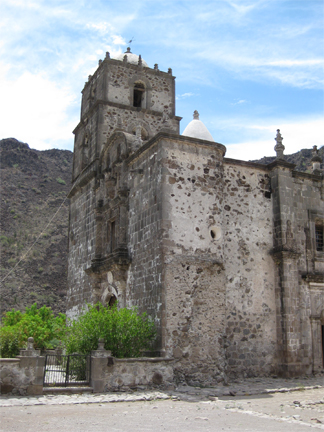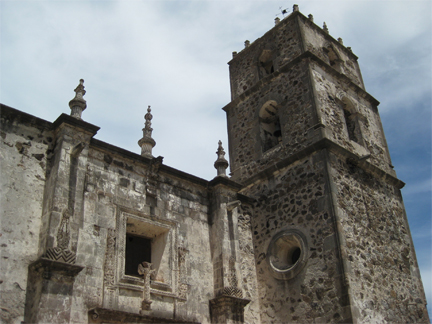 |  |
Article and photos by David Kier

The second California mission was originally founded 5 miles north, but moved to the current location in 1710. The church was built from 1744 to 1758, and remains as the finest preserved stone mission in Baja California. Here is how the mission came to be:
Having heard of an Indian settlement (rancheria) of La Vigge hidden away amid a circle of virtually impassable mountains, Padre Francisco Maria Piccolo forced his way afoot through rocky arroyos and precipitous passes until he reached the site. The trek was arduous indeed. Thinking the rancheria was termed La Vigge, which to the Indians meant mountain, each time he came upon a new group of Indians and inquired of the way to La Vigge, they would send him off to a new series of mountain peaks. Having arrived at last, he founded Mission San Francisco Javier de Biaundo on May 11, 1699, about five miles north of the present mission, developed later by Padre Ugarte.The original mission had a spacious chapel adjoined by a dwelling for the missionary and a small church of adobe, roofed with tile.
 It was endowed with a $10,000 principal investment along with other sizeable gifts by Bachelor Don Juan Cavallero y Ocio, a priest.
It was endowed with a $10,000 principal investment along with other sizeable gifts by Bachelor Don Juan Cavallero y Ocio, a priest.
In 1906, explorer Arthur North believed that he had located this original mission about ten miles down the arroyo where, hidden away by brush, he glimpsed a great stone corral. Near it, among giant cardons, was an ancient mission church seventy-five feet long by fifteen feet wide and about twenty-five feet high. Within were two rooms and a ruined altar. Growing trees had ripped off the roof, but the cut stone walls had withstood time and earthquakes. Other stone buildings stood a few yards away alongside a magnificent cistern with steps leading down into it and a stone aqueduct to carry water. Local Indians of North's time referred to it as the Mission of La Presentacion, but since chroniclers recorded no such mission, North concluded that it was the first San Xavier erected in 1699.
During the drought that occurred around the year 1710, the original mission headquarters was obliged to move to a nearby visiting station and farm of San Pablo, a location that turned out to be so promising that when Padre Ugarte came to replace Padre Piccolo, he moved the mission there. Costing over a million pesos -- gained from profits of pearl fisheries supposedly discouraged by the Jesuits -- the ambitious new mission was endowed with a belfry, spires, and altars that required many years of construction. Cut in stone above the lintels of the door is the date 1751. Today it is the most architecturally impressive mission on the Peninsula, and remains in good condition.

Spectacular black lava cliffs rise hundreds of feet behind it, casting the mission's white Moorish domes and bell tower into stark relief. To the north, east, and west, great double doorways open into the mission. Within its vaulted interior, light filters through the peninsula's first stained glass windows, falling upon three gold-leaf altars shipped from Mexico and reassembled. Dominating the main altar is a statue of San Francisco Javier, surrounded by eight life-size valuable oil paintings. A spiral staircase reaches the choir loft. There presently are three bells in the tower, two dated 1761 and a third 1803. It is interesting that an early Jesuit description of this mission endowed it with eight bells, more than other missions.
Due to the degree of culture fostered by Padre Ugarte, life was more comfortable here for the padres than at other missions, but perhaps not for the converts when he grabbed them by a hank of hair and swung them to and fro for jesting during Rosary. Upon learning that the cause of merriment was due to his mistakes with their language, however, he tried to perfect his accent.
As he had so successfully achieved quiet during Rosaries, he used similar techniques to encourage indolent Indians to harvest wheat, corn and other grains. Then, like a purveyor-general, he stood over them while they irrigated the stone soil to grow grapes for his wine. To encourage modesty, he imported sheep from the mainland along with a master weaver to teach them to weave cloth so they could cover themselves like good Christians.
Thus, Mission San Francisco Javier reached a high degree of prosperity. Padre Ugarte ruled harshly, but he built well. Of all the peninsula missions, this one is the most rewarding.
GETTING THERE
Highway 1 to San Javier, approx. 1 hour driving time:
0.0 San Javier road at Hwy. 1, exactly one mile south of the signed Loreto entrance road.
8.2 Rock art parking on left, at arroyo crossing short walk to site.
9.8 End of pavement in 2009, good graded road continues up. Five additional miles paved per report in 2011.
11.4 Rancho Las Parras and chapel.
16.1 Rancho Viejo, the original location of Mision San Javier (1699-1710).
17.3 Road to San Jose Comondu junction.
21.7 San Francisco Javier de Biaundo
GPS: 25º51'36.9" 111º32'37.0"


